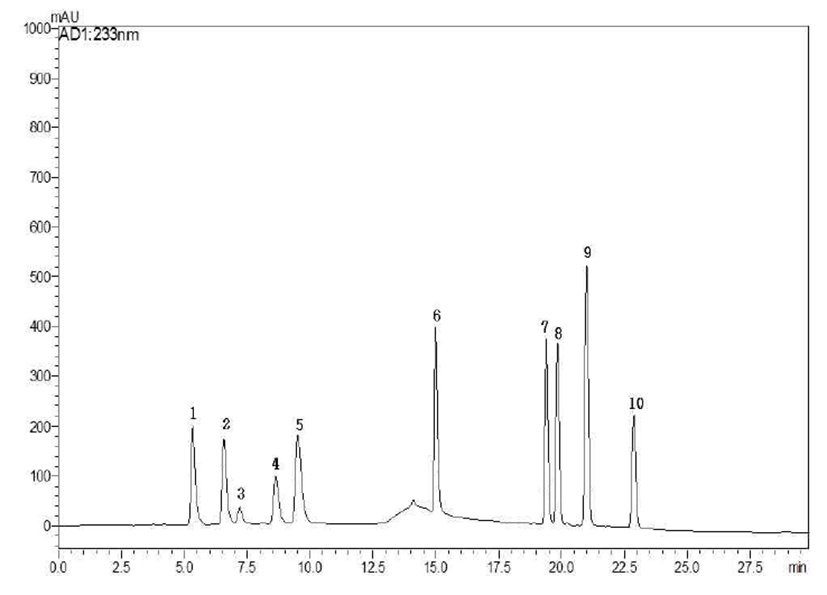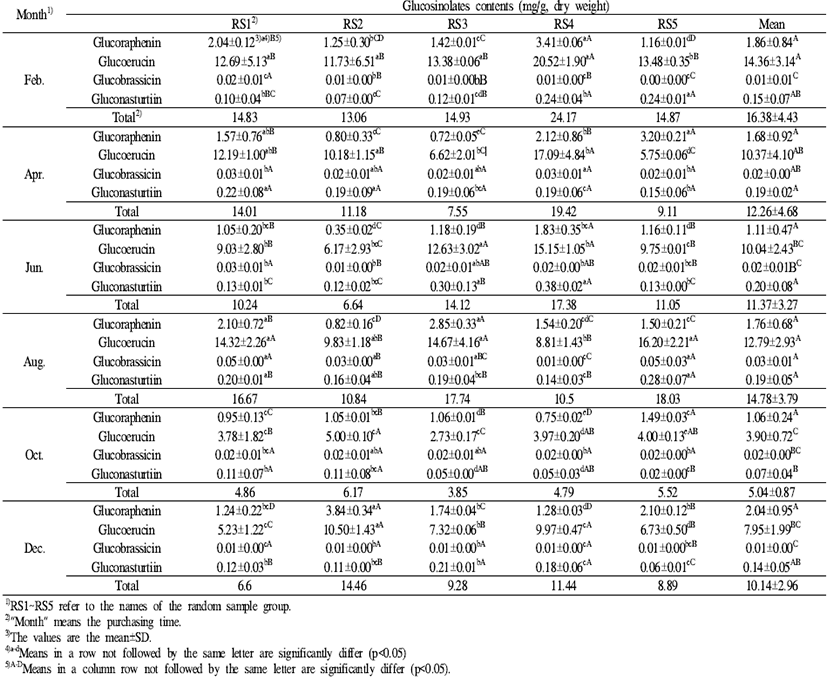서 론
새싹채소는 간편하고 건강한 식단을 지향하는 현대인들 사이에서 널리 이용되는 신선편의식품 중 하나이며, 브로 콜리싹, 메밀싹, 무싹, 콜라비싹, 알팔파싹 등이 주로 이용 되고 있다(1,2). 새싹채소는 완전한 성장을 위해 영양소 및 식물 생리활성물질을 생합성하는 시기에 이용되는 채소를 의미하며, 종자나 완전히 성숙한 채소보다 높은 생리활성 물질을 가진다고 보고되어 있다(3-6). 새싹채소로 널리 이 용되고 있는 십자화과 식물은 글루코시놀레이트와 페놀성 화합물 등이 다량 함유되어 있는 것으로 알려져 있다. 그 중 특유의 맛과 향을 가지고 있어 샐러드나 곁들이 음식 등으로 이용되는 무 새싹채소는 항암물질로 알려진 인돌계 화합물, 비타민 및 Ca, P, Fe, Mg 등의 알카리성 원소 등을 함유하여 그 영양학적 가치가 매우 높은 식품이다(7-10).
새싹채소에 대한 미생물적 오염에 대한 연구에서는 부적 절한 유통과정에 따른 위해 미생물의 위험성이 있으며(11), 특히, 총균수와 대장균수가 비교적 높게 검출되어(12), 식 중독의 위험성이 높은 식품으로 보고되고 있다(13). 또한 생산 기간별 콩나물에 대한 미생물 오염도를 측정한 결과에 서도 봄과 여름에서 미생물 오염도가 더 높은 것으로 보고 되었다(14). 그러나 생육기간이 5~7일정도로 짧고 실내에 서 재배가 가능하여 사계절 내내 수확되고 유통되어지고 있는 무 새싹채소에 대한 미생물 및 영양학적인 품질 평가 에 대한 연구는 미미한 수준이다.
따라서 본 연구에서는 연중 생산∙유통되는 무 새싹채소 의 미생물 및 영양학적 품질 변화를 조사하기 위하여 2개월 마다 시료를 구입하여 미생물적 품질지표로서 총균수 및 대장균군수를 측정하였고, 영양학적 품질지표로서 총 페 놀, 총 카로티노이드, 총 글루코시놀레이트, 개별 글루코시 놀레이트 및 항산화 활성을 조사하였다.
재료 및 방법
2012년 12월부터 2013년 10월까지 경기도 성남의 대형 마트, 백화점 및 온라인 쇼핑몰 등을 통해 생산자가 다른 5종류(RS1~RS5)의 무 새싹채소를 두 달 간격으로 구입하 였다. 시료의 일부는 즉시 총균수와 대장균군의 오염도를 알아보는데 사용하였고, 나머지 시료는 액체질소로 동결시 켜 동결건조기(FD8508, Ilshin Lab Co., Ltd., Yangju-si, Gyeonggi-do, Korea)를 이용하여 건조하였다. 건조된 시료 는 분쇄 후 60 메쉬 체에 쳐서 시료로 이용하였으며, 분쇄한 시료는 4°C의 냉장실에 보관하면서 실험에 이용하였다.
동결건조 된 시료 0.2 g에 10배에 해당하는 80% 에탄올을 가한 후, 30°C shaking incubator(JSSI-100C, JSR Co., Gongju, South Chungcheong Province, Korea)에서 150 rpm 으로 18시간 동안 추출하였다. 이 과정을 3회 반복 추출하여 모아진 추출액은 여과지(Whatman No. 2)로 여과하여 회전 식 증발농축기(Rotavapor R-205, Buchi, Flawil, Swizerland) 로 감압농축한 후, 80% 에탄올로 50 mL의 메스플라스크에 정용하여 이를 추출액으로 사용하였다.
생시료 10 g을 멸균백에 담아 0.85% 멸균 생리식염수 용액 90 mL를 넣고 stomacher(400 Circulator, Seward, West Sussex, England)로로 균질화 시킨 후, 10배씩 단계적으로 희석시켜 배지에 분주하였다. 37°C 배양기에서 48시간 배 양한 뒤, 형성된 colony를 계수하여 시료 당 colony forming unit(CFU)의 수치로 나타내었으며, 총 균수는 plate count agar(PCA, BD Difco, Franklin Lakes, New Jersey, USA) 배 지, 대장균군수는 chromocult(VM659026 435, Merck Co., Darmstadt, Germany) 배지를 사용하였다.
시료의 총 페놀 함량은 Folin-Ciocalteus법(15)에 따라 함 량을 측정하였다. 시료 0.5 mL에 1 N Folin-Ciocalteus 시약 을 0.5 mL 첨가하고, 2% sodium carbonate anhydrous 포화용 액 10 mL를 첨가하여 1시간 동안 반응시킨 후 흡광도를 측정하였다. 흡광도는 750 nm에서 UV-spectrophotometer (V-570, Jasco Co., Tokyo, Japan)로 측정하였으며, 표준물질 로는 gallic acid(Sigma Chemical Co., Louis, MO, USA)를 사용하였다.
시료의 카로티노이드 함량은 Kim 등(16)의 방법을 이용 하여 측정하였다. 동결 건조한 시료 0.2 g에 0.1% BHT를 포함하는 에탄올 6 mL를 혼합하여 85°C 드라이오븐에서 5분간 예열시키고, 80% KOH 120 μL를 첨가하여 85°C 드라 이오븐에서 10분 동안 반응시킨 다음, 상온에서 냉각시켰 다. 여기에 증류수와 hexane 용액을 각각 3 mL씩 첨가하여 섞어주고 원심분리(3,500×g, 15min)하여 상층액만 수집한 후, 남은 잔여물에 다시 증류수와 hexane 용액을 3 mL씩 첨가하고, 동일한 과정을 1회 더 반복하여 수집된 상층액을 모아 질소농축 하였다. 질소농축한 건고물은 메탄올과 methyl tert-butyl ether(MTBE)를 1:1로 혼합한 용매에 녹여 450 nm에서 흡광도를 측정하였다. 분석에는 ELISA reader(680, Bio-rad, Hercules, CA, USA)를 사용하였으며, 표준물질로는 β-carotene(Sigma Chemical Co.)을 사용하였 다.
총 글루코시놀레이트는 Kestwal(17)의 방법을 이용하여 측정하였다. 추출액은 동결 건조된 시료 0.1 g에 99% 에탄 올 3 mL를 넣고 30°C에서 100 rpm으로 20시간동안 교반하 여 추출한 다음 상층액을 여과지(Whatman, No.1)로 여과한 것과 남은 잔여물에 99% 에탄올 3 mL를 넣어 1분간 교반한 후 여과한 것을 모아서 실험에 사용하였다.
96-well cell culture plate(SPL)에 추출액 20 μL와 2 mM sodium tetrachloropalladate solution 300 μL를 넣어 실온에서 30분간 반응시킨 후, 450 nm에서 ELISA reader로 흡광도를 측정하여 함량을 계산하였다. 표준물질로는 sinigrin hydrate (Sigma Chemical Co.)를 사용하였다.
Chung(18)의 방법을 변형하여 무 새싹채소에 함유된 글 루코시놀레이트의 정성 및 정량분석을 실시하였다. 동결 건조된 시료 0.2 g에 메탄올 4 mL를 첨가하여 70°C 항온 수조에서 15분간 교반 추출한 후 실온으로 냉각시킨 추출 물의 상층액을 여과지(Whatman No.2)로 여과하였다. 여과 후 남은 잔여물에 메탄올 2 mL을 넣고 교반하여 여과하는 과정을 2회 반복한 후, 여과된 추출액을 모아 55°C에서 질소 농축 시켰으며, 건고물을 메탄올 2 mL로 녹여 실험용액으 로 사용하였다.
Teflon frits(6 mL, Supelco, Sigma-Aldrich, Louis, MO, USA)로 양 끝을 막은 syringe에 200°C에서 overnight시켜 활성화시킨 florisil sorbent를 0.8 g 담아 제작한 column에 30%(v/v) dichloromethane을 포함하는 hexane 용액을 흘려 씻어주었다. 여기에 추출한 시험용액 300 μL를 30%(v/v) dichloromethane을 포함하는 hexane 용액 5 mL와 섞어 통과 시킨 후, 30%(v/v) dichloromethane을 포함하는 hexane 용액 5 mL를 다시 흘려주었다. 마지막으로 30% ethyl acetate를 포함하는 메탄올 용액 5 mL를 흘려 정제된 것을 모아 50°C 에서 질소농축한 뒤, 건고물에 HPLC용 증류수 300 μL를 첨가하여 녹인 것을 0.45 μm syringe filter(PVDF, Whatman, England)로 여과하여 분석 시료로 사용하였다.
분석기기는 HPLC(Nano 2D LC system, shimadzu, Kyoto, Japan)를 이용하였으며, column은 Intersil ODS2(C18) column(4.6×250 mm, GL Science, Tokyo, Japan), 이동상으 로는 (A) formic acid가 첨가된 30 mM ammonium acetate (pH 5.0)와 (B) 메탄올을 이용하였다. 분석시간은 총 40분으 로, 처음 5분은 (A)를 100%로, 그 다음 12분 동안 (A)를 70%까지 낮춘 다음 8분간 유지하고 다시 5분 동안 (A)를 100%로 높여준 다음 10분간 유지하였다. 또한, flow rate는 1 mL/min, injection volume은 10 μL, 분석파장은 233 nm로 설정하였다. 표준물질로서 glucoiberin, gluconapin, glucoerucin은 ChromaDex™(Muirland Blvd, IL, USA)에서 구입하였다. Progoitrin, glucoraphanin, glucoraphenin, glucotropaeolin, glucobrassicin, gluconasturtiin은 Cfm Oskar Tropitzsch GmbH(Marktredwitz, Germany)에서 구입하였으 며, sinigrin은 Sigma Chemical Co.에서 구입하여 사용하였 다(Fig. 1).

무 새싹채소의 항산화 활성은 Lee 등(19)의 방법을 참고 하여, 2,2-diphenyl-β-picrylhydrazyl(DPPH) 라디칼 소거능 을 측정하였다. 추출액을 단계적으로 희석하여 4 mL cuvette에 0.7 mL씩 담고, 0.1 mM DPPH 용액 2.8 mL를 넣어 실온에서 30분간 반응시킨 후, 517 nm에서 흡광도를 측정하였다. 분석에는 UV-spectrophotometer를 이용하였으 며 대조구로는 80% 에탄올을 이용하였고, 다음의 계산식을 이용하여 DPPH 라디칼 소거능(%)을 계산하였다. 결과 값 은 IC50 값으로 나타내었다.
DPPH radical scavenging activity(%)=(1-Abssample/Abscontrol)×100
결과 및 고찰
구매시기에 따른 무 새싹채소의 일반세균수와 대장균군 수를 측정한 결과, 일반세균수는 평균값이 6.39~8.22 log CFU/g의 범위로 6월에 가장 높고 12월에 가장 낮게 나타났 으며, 대장균군수는 평균값이 6.01~7.36 log CFU/g로 일반 세균수와 마찬가지로 6월에 가장 높고 12월에 가장 낮았다 (Table 1, 2). 이러한 결과는 Kang(12)의 연구에서 새싹채소 의 총 호기성 균의 평균값이 7.95 log CFU/g, 대장균군수의 평균값이 6.69 log CFU/g으로 나타난 것과 유사한 값을 나타내며, Lee(20)가 무순의 일반세균수를 7.3 log CFU/g, 대장균군수를 5.5 log CFU/g으로 보고하고, Jo(21)가 새싹 채소의 일반세균수를 8.0~8.9 log CFU/g으로 보고한 것과 도 비슷하거나 높은 값을 나타내었다. 또한, Park(14)이 보 고한 여름 콩나물이 겨울보다 오염도가 높게 나타났던 결과 와도 비슷한 양상을 보인다. 이는 온도와 습도가 높은 계절 의 영향인 것으로 생각되며, 따라서 이런 결과로 미루어 볼 때 무 새싹채소의 생산 및 유통과정에서 겨울보다 여름 에 더 주의를 기울여야 할 것이다. 대장균군의 검출은 대장 균 및 병원성 균인Shigella나Salmonella 등이 검출될 가능 성을 의미하므로, 무 새싹채소의 생산 및 소비에서 병원성 미생물의 증식을 억제할 수 있는 다양한 수단이 필요할 것으로 판단되었다.
페놀성 화합물은 다양한 생리활성을 나타내는 것으로 알려져 있으며, 자유 라디칼을 소거시키는 것이 그 중 가장 대표적인 역할로 알려져 있다(22,23). 총 페놀 함량은 플라 보노이드나 안토시아닌 등과 같은 화합물의 총량을 의미하 는데(24), 무 새싹채소 추출물은 총 페놀 함량이 높고, 항산 화 활성이 높게 나타나 식품첨가물이나 보존제 등의 기능성 소재로 활용될 가능성이 있는 것으로 알려져 있다(25). 본 연구에서 무 새싹채소의 총 페놀 함량은 평균 15.86~17.96 GAE mg/g으로 나타났다. 본 연구에서 무 새싹채소의 총 페놀 함량은 평균 15.86~17.96 GAE mg/g으로 나타났으며, 월별 총 페놀함량간의 유의적인 차이는 나타나지 않았다 (Table 3). 계절별 비교에서도 모든 시료에서 여름과 겨울의 함량간의 유의차가 나타나지 않아 총 페놀함량은 구매 시기 에 영향을 받지 않는 것으로 판단되었다.
카로티노이드는 노란색 또는 붉은색을 내는 천연 색소 로, 동∙식물 뿐만 아니라 미생물에도 존재한다. 일부 카로티 노이드는 비타민 A의 전구체로서 망막질환, 백내장, 심장 병 및 암 등을 예방하는 효과가 있다고 알려져 있으며, 그.
밖에도 항산화효과 등 다양한 효과를 나타내는 것으로 보고되어 있다(26,27). 무 새싹채소의 구입시기별 총 카로 티노이드 함량의 변화에 대한 결과는 Table 4 에 나타내었 다. 무 새싹채소의 총 카로티노이드 함량은 구매시기별 평 균 8.09~12.81 mg/g 수준을 나타내었으며, 계절별 분류에 서도 겨울철이 12.30±1.13 mg/g으로 여름철의 9.75±0.83 mg/g에 비하여 유의적으로 높은 함량을 나타내었다. 월별 함량 비교에서는 4월이 가장 낮은 함량을 보인 반면 2월에 는 가장 높은 함량을 나타내었으며, 전체적인 경향을 볼 때 4, 6, 8월이 2, 10, 12월에 비하여 상대적으로 낮은 총 카로티노이드 함량을 나타내었다. Kim 등(28)에서 무의 계 절별 베타카로틴 함량 분석을 통해서 가을 무에서의 함량이 53 μg/100 g으로 다른 계절에 비하여 가장 높은 함량을 나타낸다고 보고된 바 있어, 본 실험과 유사한 결과를 나타 난 것을 확인할 수 있었다.
글루코시놀레이트는 배추과(Brassicaceae) 작물의 독특 한 맛과 향을 만드는 고유한 기능성 물질로, 분해효소인 myrosinase와 반응하여 생성되는 isothiocyanate가 항균, 항 암효과 등을 나타내는 것으로 알려져 있어 특정 글루코시놀 레이트의 성분을 분석하고 증진시키고자 하는 육종 연구가 지속적으로 수행되어지고 있는 추세이다(29).
무 새싹채소의 구입시기별 총 글루코시놀레이트 함량의 변화에 대한 결과는 Table 5에 나타내었다. 총 글루코시놀 레이트 함량의 구매시기별 평균은 52.07~73.47 mg/g 수준 을 나타내었으며, 계절별 분류에서는 겨울철과 여름철의 함량에서 유의적인 차이가 나타나지 않았다. 월별 함량 비 교에서는 12월에 73.47±4.67 sinigrin mg/g으로 가장 높은 값을 나타내었으며, 10월에 52.07±11.93 sinigrin mg/g으로 가장 낮은 값을 나타내었다.
HPLC를 이용한 개별 글루코시놀레이트의 분석에서는 glucoraphenin, glucoerucin, glucobrassicin, gluconasturtiin이 무 새싹채소로부터 검출되었으며, 이를 개별적으로 분석하 여 그 합을 구한 결과 연중 평균이 5.04~16.38 mg/g수준을 나타내었다(Table 6). 개별 글루코시놀레이트의 합은 2월에 16.38±4.43 mg/g으로 가장 높은 값을 보였으며, 10월에 5.04±0.87 mg/g으로 가장 낮은 값을 나타내었다. 총 글루코 시놀레이트의 함량 비교와 개별 글루코시놀레이트의 총 함량을 비교했을 때 일치하지 않았는데, 이는 crude한 총 글루코시놀레이트 함량을 분석한 것과, 선별된 4개의 개별 글루코시놀레이트의 합으로 나타내는 방법적인 차이에서 발생하는 것이라고 여겨진다. 분석된 개별 글루코시놀레이 트 compounds 중에서는 glucoerucin의 함량이 가장 높게 나타났으며, glucoraphenin, gluconasturtiin, glucobrassicin 의 순서로 높은 함량을 나타냈다.

|
시기별 배추의 총 글루코시놀레이트 함량 변화는 봄에 수확 한 배추가 22 μg/g으로 가을에 수확한 배추가 13 μg/g인 것에 비하여 유의적으로 높게 나타낸 것으로 보고하였는데 (30), 이는 8월과 10월에 가장 낮은 총 글루코시놀레이트 함량을 나타낸 본 실험의 결과와 유사한 결과를 나타낸다. 또한, 순무의 총 글루코시놀레이트 함량도 5월에 222±32 μmol/100 g으로 8월의 144±21 μmol/100 g에 비하여 유의적 으로 높게 나타난 바 있다(31). 반면, Kim 등(32)은 5~7월에 수확한 신선배추가 12~4월에 수확한 신선배추에 비해 총 글루코시놀레이트 함량이 높게 나타낸 것으로 보고하였는 데, 이는 본 연구의 결과와는 상이한 것으로, 이러한 총 글루코시놀레이트 함량의 경향 차이는 Agerbirk 등(33)이 보고한 것과 같이 품종과 재배계절에 따른 차이뿐만 아니라 재배방식에 기인한 결과로 보여진다.
DPPH법은 항산화 물질의 전자공여능으로 인해 방향족 화합물 및 방향족 아민류에 의해 환원되어 짙은 자색을 띄는 DPPH 시약이 탈색되는 정도를 측정하는 것으로, 항산 화 능력을 나타내는 척도가 된다고 알려져 있으며, 천연소 재로부터 항산화 물질을 검색하는데 많이 이용된다(34,35). 구매시기별 DPPH 라디칼 소거능의 IC50 값을 구한 결과는 Table 7에 나타내었다. 월 별 항산화활성을 비교하면, 2월에 2.51±0.47 mg/mL로 가장 낮은 IC50값을 나타내어 항산화활 성이 가장 높았고, 6월에 4.51±0.41 mg/mL로 가장 높은 값이 측정되어 항산화활성이 가장 낮았다. 계절별 비교에 서 겨울이 여름보다 항산화 활성이 높게 나타났는데, 이는 Ulva rigida의 DPPH 라디칼 소거능이 8~10월에 비해 2, 3월에 높게 나타났다는 보고(36)와 유사한 경향을 보이며, 이를 통해 온도가 비교적 낮은 시기에 항산화 활성이 높아 짐을 알 수 있었다.
요 약
본 연구는 국내에서 생산∙유통되는 무 새싹채소의 미생 물 및 영양학적 품질지표를 조사하기 위하여 2개월에 한번 씩 무 새싹채소를 구매한 후, 미생물 오염도, 총 페놀함량, 총 카로티노이드 함량, 총 글루코시놀레이트 함량 및 개별 글루코시놀레이트 화합물을 분석하고, 항산화활성을 측정 해보았다. 일반세균수와 대장균군수는 평균 7.45±0.73 log CFU/g과 6.55±0.61 log CFU/g을 나타내었으며, 겨울철에 는 각각 6.70±0.61 log CFU/g과 6.09±0.50 log CFU/g으로 낮았고, 여름철에는 각각 7.91±0.15 log CFU/g과 6.94±0.17 log CFU/g으로 높은 오염도를 나타내었다. 총 페놀함량은 평균 16.82±0.69 mg/g을 나타내었으며 구매시기별 유의차 는 없는 것으로 확인되었다. 총 카로티노이드 함량은 평균 값이 10.73±2.08 mg/g로, 계절별로 비교했을 때 겨울이 여 름보다 높은 함량을 나타내었다. 총 글루코시놀레이트 함 량은 평균 65.80±12.68 mg/g이었으며, 12월에 73.47±4.67 mg/g으로 가장 높은 함량을 보였으나, 구매시기에 따른 유의적인 차이는 나타나지 않았다. 개별 글루코시놀레이트 함량은 glucoerucin, glucoraphenin, gluconasrutiin, glucobrassicin의 순서로 높게 나타내었으며, glucoerucin을 제외한 성분들은 구매시기에 따른 성분함량에서 유의적 차이를 나타내지는 않았다. 항산화 활성은 DPPH 라디컬 소거능으로 측정하였는데, 2월에 가장 높고 6월에 가장 낮 은 항산화 활성을 보여, 겨울철이 여름철에 비해 항산화활 성이 높은 것을 알 수 있었다. 따라서, 무 새싹채소의 미생물 오염도, 총 카로티노이드 함량 및 항산화 활성은 구매시기 에 따라 함량 및 활성의 변화를 보였으나, 총 페놀 함량, 총 글루코시놀레이트는 구매시기별 유의적인 차이 없음을 확인할 수 있었다.










